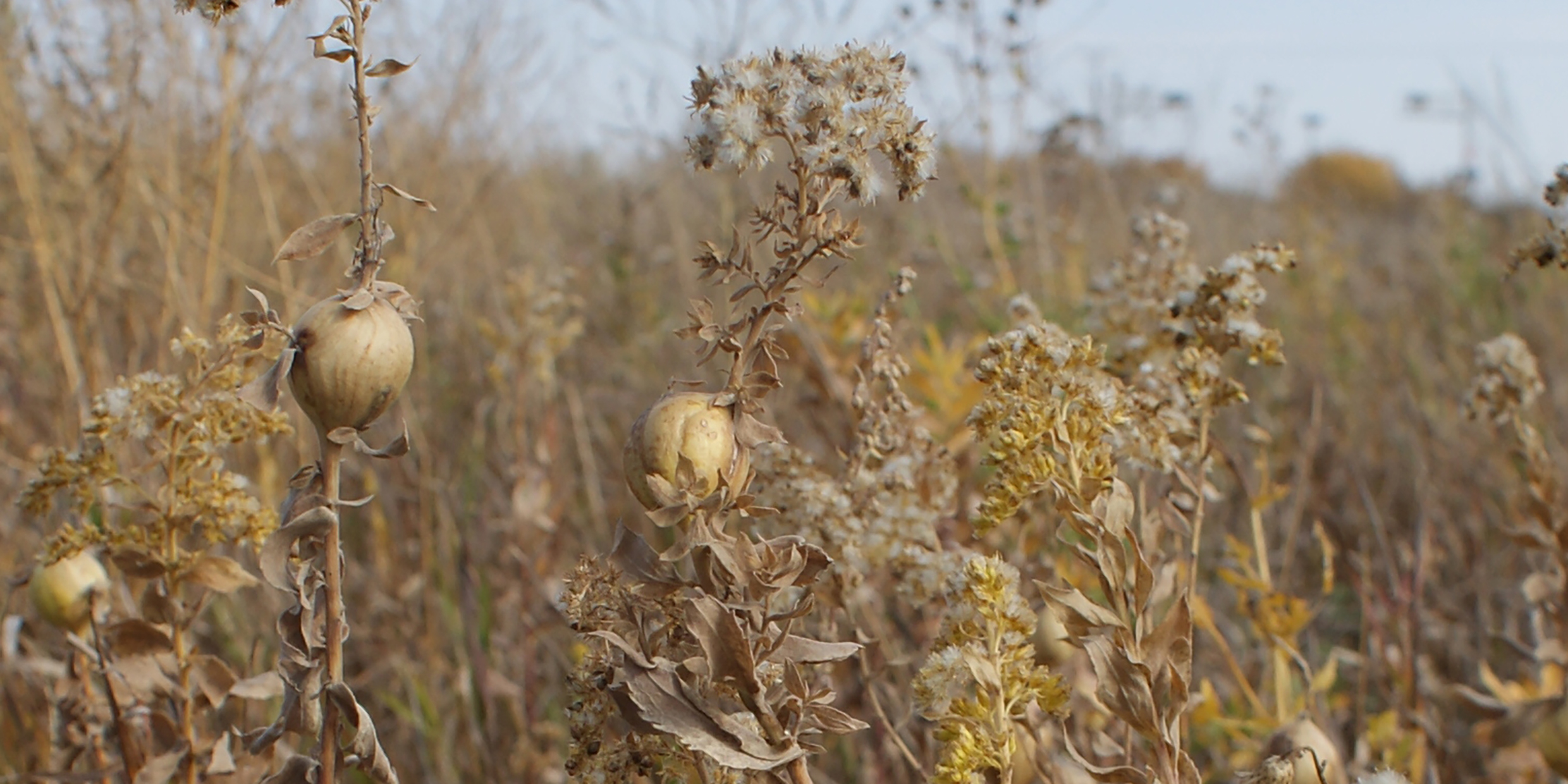Originally published 30 January 1995
Among massed goldenrods at the side of the path, my eye fell upon a plant with a spherical swelling in the stem — a bulge like a snake digesting a fat, round meal. Suddenly, I was swept by childhood memories.
But before waxing nostalgic, let me tell you about goldenrod galls.
There is a tiny female fly, Eurosta solidaginis, of the fruit fly family, that lays her eggs on fresh goldenrod stems in early summer. An egg hatches and the larva burrows into the stem, where it excavates a tiny cavity and feeds upon the tissue of the plant. By some sort of chemical sabotage, the insect causes the goldenrod to grow a fat round ball around its cavity. Inside this comfy nest, the larva winters.
In spring, the larva becomes active and chews a tunnel out to — but not through — the skin of the gall. Then it retreats to the center and pupates, becoming an adult fly. The fly crawls down the tunnel, pops the skin, and emerges to mate, lay eggs, and start the cycle again.
When we were kids, we looked for goldenrod galls in winter or spring when the stems had gone brown and stiff. We broke the stems off at the base, and then again just above the gall. With these drumstick instruments we rapped each other over the head. We called them knockers.
I should distinguish knockers from conkers. To make a conker, you take a shiny black horse chestnut, drill a hole through it and tie it on the end of a string. You then swing your conker against an opponent’s conker, again and again, until one of them cracks and a winner is declared. As far as I know, this game is British in origin, and once when my family lived in London my son had a consistently victorious horse chestnut that he called William the Conker.
But back to knockers. Sometimes two galls form on a single goldenrod stem, making a double knocker. A triple knocker was a prized rarity. And once I found a quadruple knocker that made me the envy of neighborhood knockerees. Probably none of us knew that inside each knocker was one or more goldenrod gall — fly larvae being shaken from their winter repose by the violence of battle.
There were other ways to use plants for childhood mischief.
Mature puffball mushrooms made marvelous smoke bombs when hurled at opponents.
A pop gun of sorts could be contrived by wrapping the bottom of the stem of a plantain around the top of the stem just at the base of the flowerhead and pulling sharply.
We waged autumn warfare with buckets of acorns and the lids of steel trash cans for shields. We reveled bravely in the ping-ping of well-directed missiles hitting the metal a few inches in front of our noses.
We devised all sorts of devious stratagems for getting dandelion seed puffs into someone’s mouth. Extracting those little parachutes was devilishly difficult.
Then, after the battles, we retired to the woods down by the creek to smoke “rabbit tobacco,” the dried leaves of a plant called sweet everlasting, that made us slightly ill but supplied a hint of macho status.
Mother Nature was not stingy with weapons, but somehow we survived our boyish propensity for knocking and conking and grew up to be reasonably peaceable citizens. What some of us took from the galls and puffballs and acorns and sweet everlasting was a lifelong interest in the natural environment.
These days I’m more inclined to cut open a winter goldenrod gall to show a child, or a friend, or a student the tiny white larva curled in its snug compartment, or, if it is last year’s gall, the neat round hole where the fly made its escape. Sometimes, upon opening a gall, one finds an interloping insect that devoured the original inhabitant and appropriated the nest.
There are other sorts of goldenrod galls that, although less useful for childhood games, are just as interesting to adults.
The larva of the moth Gnorimoschema gallaesolidaginis causes an elliptical swelling in goldenrod stems. This creature doesn’t start its burrowing until spring, and by the following winter it is gone, leaving a nice round escape hole, if it hasn’t meanwhile become someone’s dinner.
A midge, Rhopalomyia solidaginis, creates an astonishing gall that causes the stem of the goldenrod to develop what looks like an elaborate woody flower. At the center of this many-petalled penthouse resides the midge larva.
Gall-observing among the goldenrods is a delightful winter sport. That I bother with these insect miracles at all I attribute to my early interest in knockers, an interest mostly unavailable to the electronic generation of kids.
While rapping each other over the head, we had the opportunity of falling in love with nature — so deeply, so knocked-out irreversibly, that the attraction lasted a lifetime.



